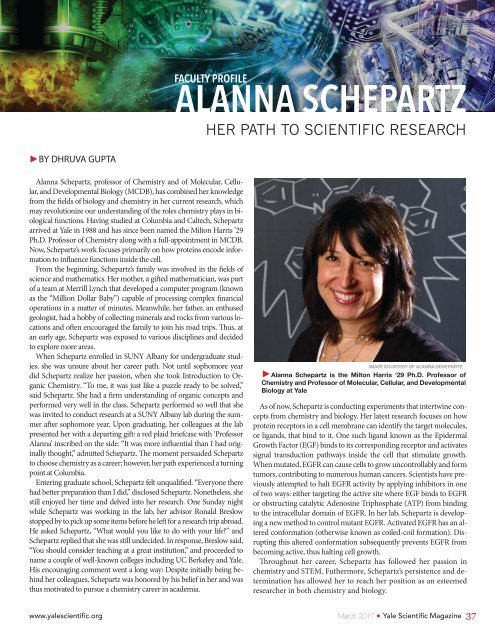YSM Issue 90.2
You also want an ePaper? Increase the reach of your titles
YUMPU automatically turns print PDFs into web optimized ePapers that Google loves.
FACULTY PROFILE<br />
ALANNA SCHEPARTZ<br />
HER PATH TO SCIENTIFIC RESEARCH<br />
►BY DHRUVA GUPTA<br />
Alanna Schepartz, professor of Chemistry and of Molecular, Cellular,<br />
and Developmental Biology (MCDB), has combined her knowledge<br />
from the fields of biology and chemistry in her current research, which<br />
may revolutionize our understanding of the roles chemistry plays in biological<br />
functions. Having studied at Columbia and Caltech, Schepartz<br />
arrived at Yale in 1988 and has since been named the Milton Harris ’29<br />
Ph.D. Professor of Chemistry along with a full-appointment in MCDB.<br />
Now, Schepartz’s work focuses primarily on how proteins encode information<br />
to influence functions inside the cell.<br />
From the beginning, Schepartz’s family was involved in the fields of<br />
science and mathematics. Her mother, a gifted mathematician, was part<br />
of a team at Merrill Lynch that developed a computer program (known<br />
as the “Million Dollar Baby”) capable of processing complex financial<br />
operations in a matter of minutes. Meanwhile, her father, an enthused<br />
geologist, had a hobby of collecting minerals and rocks from various locations<br />
and often encouraged the family to join his road trips. Thus, at<br />
an early age, Schepartz was exposed to various disciplines and decided<br />
to explore more areas.<br />
When Schepartz enrolled in SUNY Albany for undergraduate studies,<br />
she was unsure about her career path. Not until sophomore year<br />
did Schepartz realize her passion, when she took Introduction to Organic<br />
Chemistry. “To me, it was just like a puzzle ready to be solved,”<br />
said Schepartz. She had a firm understanding of organic concepts and<br />
performed very well in the class. Schepartz performed so well that she<br />
was invited to conduct research at a SUNY Albany lab during the summer<br />
after sophomore year. Upon graduating, her colleagues at the lab<br />
presented her with a departing gift: a red plaid briefcase with ‘Professor<br />
Alanna’ inscribed on the side. “It was more influential than I had originally<br />
thought,” admitted Schepartz. The moment persuaded Schepartz<br />
to choose chemistry as a career; however, her path experienced a turning<br />
point at Columbia.<br />
Entering graduate school, Schepartz felt unqualified. “Everyone there<br />
had better preparation than I did,” disclosed Schepartz. Nonetheless, she<br />
still enjoyed her time and delved into her research. One Sunday night<br />
while Schepartz was working in the lab, her advisor Ronald Breslow<br />
stopped by to pick up some items before he left for a research trip abroad.<br />
He asked Schepartz, “What would you like to do with your life?” and<br />
Schepartz replied that she was still undecided. In response, Breslow said,<br />
“You should consider teaching at a great institution,” and proceeded to<br />
name a couple of well-known colleges including UC Berkeley and Yale.<br />
His encouraging comment went a long way: Despite initially being behind<br />
her colleagues, Schepartz was honored by his belief in her and was<br />
thus motivated to pursue a chemistry career in academia.<br />
IMAGE COURTESY OF ALANNA SCHEPARTZ<br />
►Alanna Schepartz is the Milton Harris ‘29 Ph.D. Professor of<br />
Chemistry and Professor of Molecular, Cellular, and Developmental<br />
Biology at Yale<br />
As of now, Schepartz is conducting experiments that intertwine concepts<br />
from chemistry and biology. Her latest research focuses on how<br />
protein receptors in a cell membrane can identify the target molecules,<br />
or ligands, that bind to it. One such ligand known as the Epidermal<br />
Growth Factor (EGF) binds to its corresponding receptor and activates<br />
signal transduction pathways inside the cell that stimulate growth.<br />
When mutated, EGFR can cause cells to grow uncontrollably and form<br />
tumors, contributing to numerous human cancers. Scientists have previously<br />
attempted to halt EGFR activity by applying inhibitors in one<br />
of two ways: either targeting the active site where EGF binds to EGFR<br />
or obstructing catalytic Adenosine Triphosphate (ATP) from binding<br />
to the intracellular domain of EGFR. In her lab, Schepartz is developing<br />
a new method to control mutant EGFR. Activated EGFR has an altered<br />
conformation (otherwise known as coiled-coil formation). Disrupting<br />
this altered conformation subsequently prevents EGFR from<br />
becoming active, thus halting cell growth.<br />
Throughout her career, Schepartz has followed her passion in<br />
chemistry and STEM. Futhermore, Schepartz’s persistence and determination<br />
has allowed her to reach her position as an esteemed<br />
researcher in both chemistry and biology.<br />
www.yalescientific.org<br />
March 2017<br />
Yale Scientific Magazine<br />
37


















